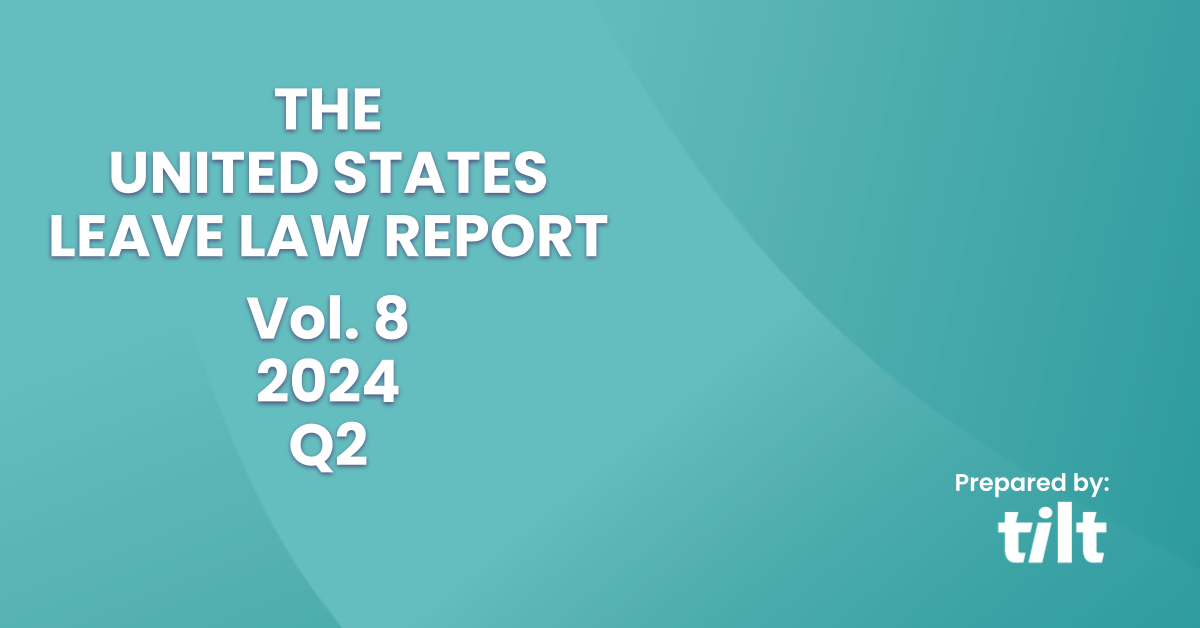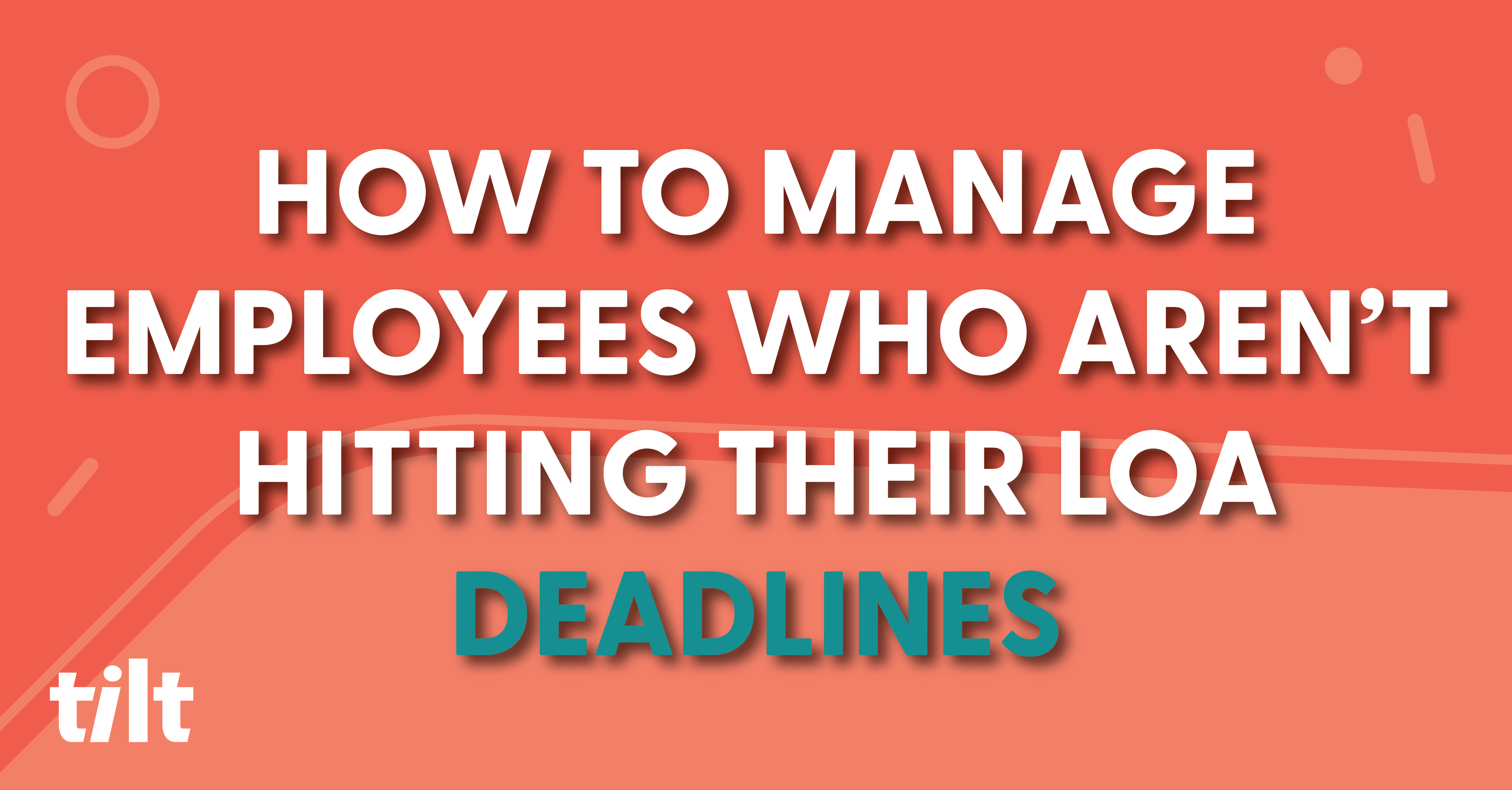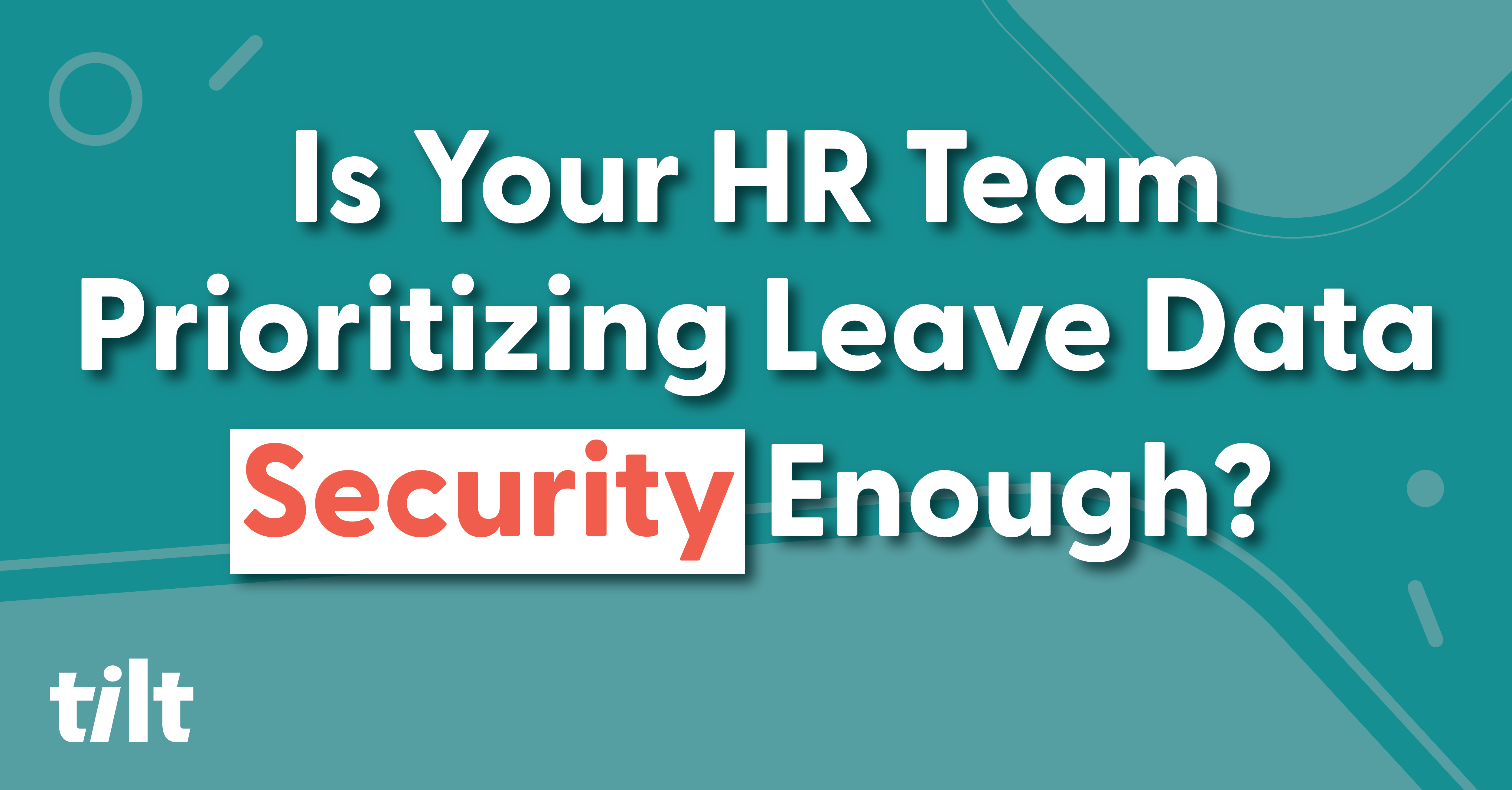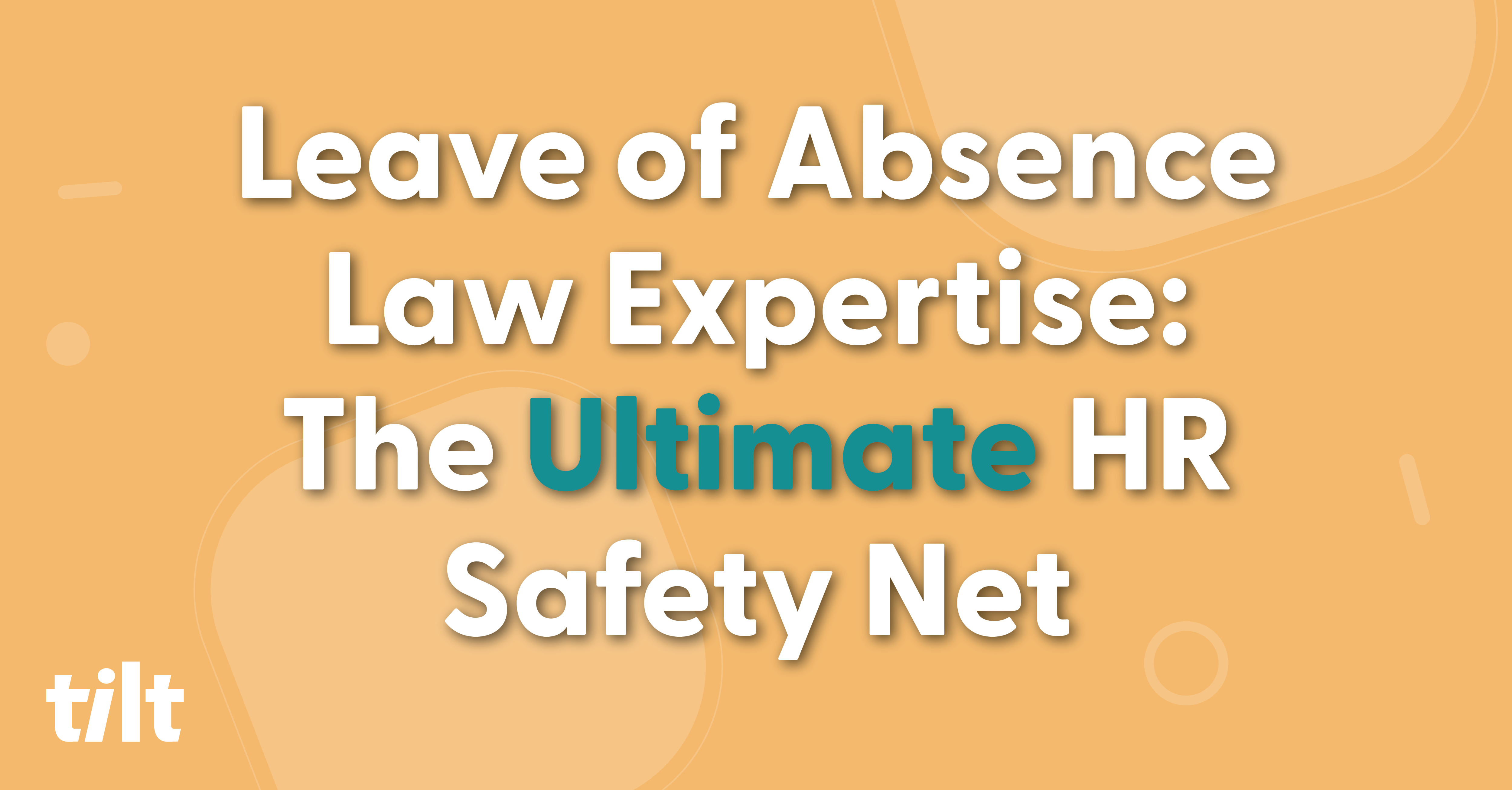It’s a new quarter and we’re committed as ever to keeping you informed and equipped with the latest developments in leave laws. We understand the importance of staying informed of these changes as you navigate the diverse and evolving People Ops landscape.
At Tilt, our team of leave law experts remains dedicated to monitoring the evolution of leave laws year-round. It’s our mission to ensure that you are well-informed and prepared to address any changes that may impact your organization.
In this report, we provide you with the most recent updates to leave programs, offering insights into how these changes might affect you and your team. We believe that staying informed is key to effectively supporting your employees while also maintaining compliance with relevant regulations.
We hope you’ll find the information contained in the United States Leave Law Report Vol. 8 valuable as you continue to prioritize the well-being of your workforce and navigate the complexities of leave laws.
Thank you for your continued trust in Tilt as your partner in managing leave programs effectively and compliantly! Should you have any questions or require further assistance, please do not hesitate to reach out.
Looking for insights from previous volumes? See what you might have missed here.
Federal Legislation: Paid Family & Medical Leave (PFML)
TL;DR: National PFML faces gridlock, so Congress considers alternate route
President Biden’s proposed budget for the 2025 fiscal year calls for a national program that would provide eligible workers with up to twelve weeks of paid family and medical leave. The proposal will likely fail due to a divided Congress–but as reported in previous leave law reports, bipartisan working groups in both chambers are drafting legislation with more modest goals and a higher likelihood of success.
The legislation will likely help states develop paid leave programs in partnership with private insurance carriers, with efforts to coordinate and harmonize programs across states. Although this approach would expand employee access to paid leave, its piecemeal nature will create more complexity than we’d see under a comprehensive, national program.
National Protections: PWFA Regulations
TL;DR: EEOC finally delivers PWFA regulations (way past due date)
The national Pregnant Workers Fairness Act (PWFA) went into effect in June 2023 and requires employers to provide reasonable accommodations to job applicants and employees with known limitations related to, affected by, or arising out of pregnancy, childbirth or related conditions.
The Equal Employment Opportunity Commission (EEOC) enforces the PWFA and was required to issue regulations clarifying the law by December 29, 2023. The EEOC finally delivered its final rule and interpretive guidance in a 408-page document on April 15, 2024.
Some key points:
- The PWFA has broad coverage: it applies not only to pregnancy and recovery from childbirth but also to fertility and infertility treatments, menstruation, lactation, abortion, miscarriage, stillbirth and many other conditions or situations associated with pregnancy or childbirth. The PWFA does not apply to bonding time.
- Under the PWFA, limitations requiring accommodation can be impediments or problems that are minor or modest and can be episodic (such as morning sickness).
- When an employee provides notice of the need for a PWFA accommodation, an employer should engage with the employee in an interactive process.
- Employers can’t require an employee to take leave if another reasonable accommodation would permit the employee to keep working.
- However, an employee can request leave as a reasonable accommodation–and depending on the circumstances, the employee may be entitled to the leave under the FMLA or a state leave law.
- Employers are not required to seek supporting documentation and can do so only when reasonable.
- The information requested must be limited in scope and employers can’t require that employees provide it on a specific form.
- The regulations specify that employers should accommodate certain requests in virtually all cases without documentation or delay, including permitting pregnant employees to carry drinking water, stand if the job requires sitting (and vice-versa), or take breaks to eat, drink or use the restroom.
Tilt has supported requests for leave as an accommodation under the PWFA since the law went into effect last year. We’ll review our PWFA leave processes and forms to ensure they’re consistent with the final regulations, which become effective on June 18, 2024.
We encourage employers to consult with counsel to review internal pregnancy accommodation policies and forms and update them as needed.
State PFML Programs - Overview
TL;DR: Two states swing and miss on mandatory PFML; one scores voluntary PFML
State PFML programs can be either mandatory or voluntary. Mandatory programs are funded through payroll deductions and guarantee wage replacement benefits to eligible employees who need leave for a qualifying reason.
In contrast, voluntary programs permit, but do not require, employers or employees to purchase PFML insurance as a private market product. The voluntary approach hasn’t meaningfully expanded employee access to paid leave, especially for lower-wage workers.
Mandatory Program Updates
Last quarter, we reported that thirteen states (and Washington D.C.) had enacted mandatory PFML laws, and that number hasn’t changed. Mandatory PFML benefits are currently available in California, Colorado, Connecticut, Massachusetts, New Jersey, New York, Oregon, Rhode Island, Washington and Washington D.C. Paid benefits will become available in Delaware, Maine, Maryland and Minnesota in 2026.
New Mexico was expected to pass legislation in February that would have made it the fourteenth state to mandate PFML benefits. The state’s PFML bill passed the Senate but narrowly failed in the House on a 34-36 vote. The bill’s backers have committed to reintroducing PFML legislation in the February 2025 session.
Also, Virginia’s Democrat-controlled state legislature passed a bill in March that would have established a mandatory PFML program. However, Republican Governor Glenn Youngkin vetoed the bill on April 5th, so Virginia will remain a voluntary PFML state for now.
Voluntary Program Updates
On April 5th, 2024, Kentucky’s governor signed a voluntary PFML bill into law, making it the ninth state to adopt this approach. Kentucky joins Alabama, Arkansas, Florida, New Hampshire, Tennessee, Texas, Virginia and Vermont as a voluntary PFML state.
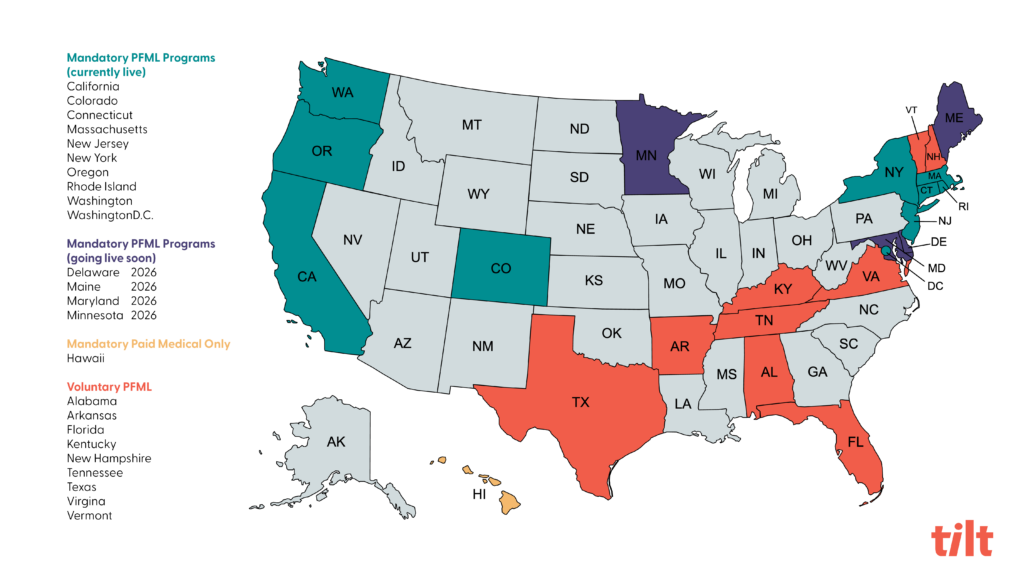
State PFML Programs - Major Updates
Oregon
TL;DR: Oregon works to organize its alphabet soup of leave laws and programs
In response to complaints about delays, Oregon’s Paid Leave Oregon (PLO) program has reportedly reduced the time from application to bank transfer from 39 days in 2023 to 29 days so far in 2024–which is within the department’s 30-day target. Call wait times remain high, averaging over an hour in the first week of April. Despite the challenges, PLO has paid over $306 million in benefits on over 50,000 approved claims in its first six months of operation.
Oregon’s legislature has also been busy addressing employer concerns about the interaction of PLO and the state’s unpaid Oregon Family Leave Act (OFLA). At present, both PLO and OFLA provide leave to eligible employees for medical, caregiving or bonding reasons. Also, under current law, PLO and OFLA leaves can run concurrently, but employees can often “stack” their leave entitlements to remain out longer.
As of July 1st, there will be changes to OFLA and PLO to ensure they’re better aligned. OFLA will apply only when PLO does not and will provide unpaid, job-protected leave in fewer situations:
- Bereavement leave (limited to 2 weeks per family member and 4 weeks a year)
- Pregnancy-related disability leave
- Sick child leave (whether a serious health condition or not)
These changes will reduce redundancy and an employee’s ability to stack PLO and OFLA leave in many, but not all, cases. In addition, employees can still stack PLO and FMLA in certain instances, so Oregon leaves will remain tricky for employers. We are updating our technology to apply these new rules when building leaves that extend beyond July 1st.
Another important change to PLO is that, as of July 1st, employees will have the right to use any accrued paid sick/vacation/PTO to top up their paid leave benefits to 100% of their regular compensation. Employers will also have the option to allow employees to use their accrued benefits to receive more than 100% of their regular pay.
State PFML Programs - Quick Hits
Washington State
TL;DR: More WA PFML info available to employers
As of January 1, 2024, Washington’s Paid Family and Medical Leave (PFML) program started providing employers greater access to information about WA PFML claims.
Employers can now access the following information in the Employment Security Division (ESD) employer portal:
- Leave type requested
- Requested duration of leave
- Approved dates of leave
- Whether benefits were paid for any given week
Although this transparency is encouraging, the portal still doesn’t provide employers with certain details needed to manage leave and coordinate benefits effectively, such as WA PFML payment amounts, the hours of benefits used or remaining, or whether leave time is continuous or intermittent.
New York
TL;DR: Paid Prenatal Personal Leave in 2025
At present, New York’s state disability benefits (NY DBL) are available to eligible pregnant employees up to four weeks before their due date, following a seven-day waiting period, which means that NY DBL typically can’t be used for prenatal appointments.
To address that deficiency, New York has amended its sick time law to require employers to provide pregnant employees with an additional 20 hours of paid time off to attend pre-natal appointments, starting in 2025.
Maryland
TL;DR: Further PFML delays expected
Maryland’s legislature has passed a bill that would once again delay the implementation of its state PFML program. If the governor signs the bill into law as expected, PFML contributions will begin on July 1, 2025, instead of October 1, 2024, and paid benefits will begin on July 1, 2026, instead of January 1, 2026.
Minnesota
TL;DR: Employer PFML obligations begin in July 2024
Although Minnesota’s PFML program doesn’t start paying benefits until 2026, most Minnesota employers must start submitting quarterly wage detail reports to the Minnesota Department of Economic Development (DEED) as of July 1, 2024.
Thank you for your interest in learning more about the latest leave laws impacting states across the country! At Tilt, we live and breathe all things leave and are passionate about supporting and educating everyone on the importance of empathetic and compassionate leaves of absence. If you have any questions about the latest leave laws or about how to better support your people when they need a leave…drop us a line.
About Tilt
Tilt is leading the charge in all things leave of absence management through easy-to-use tech and human touch. Since 2017, our proprietary platform and Empathy Warriors have been helping customers make leave not suck by eliminating administrative burdens, keeping companies compliant, and providing a truly positive and supportive leave of absence experience for their people.

